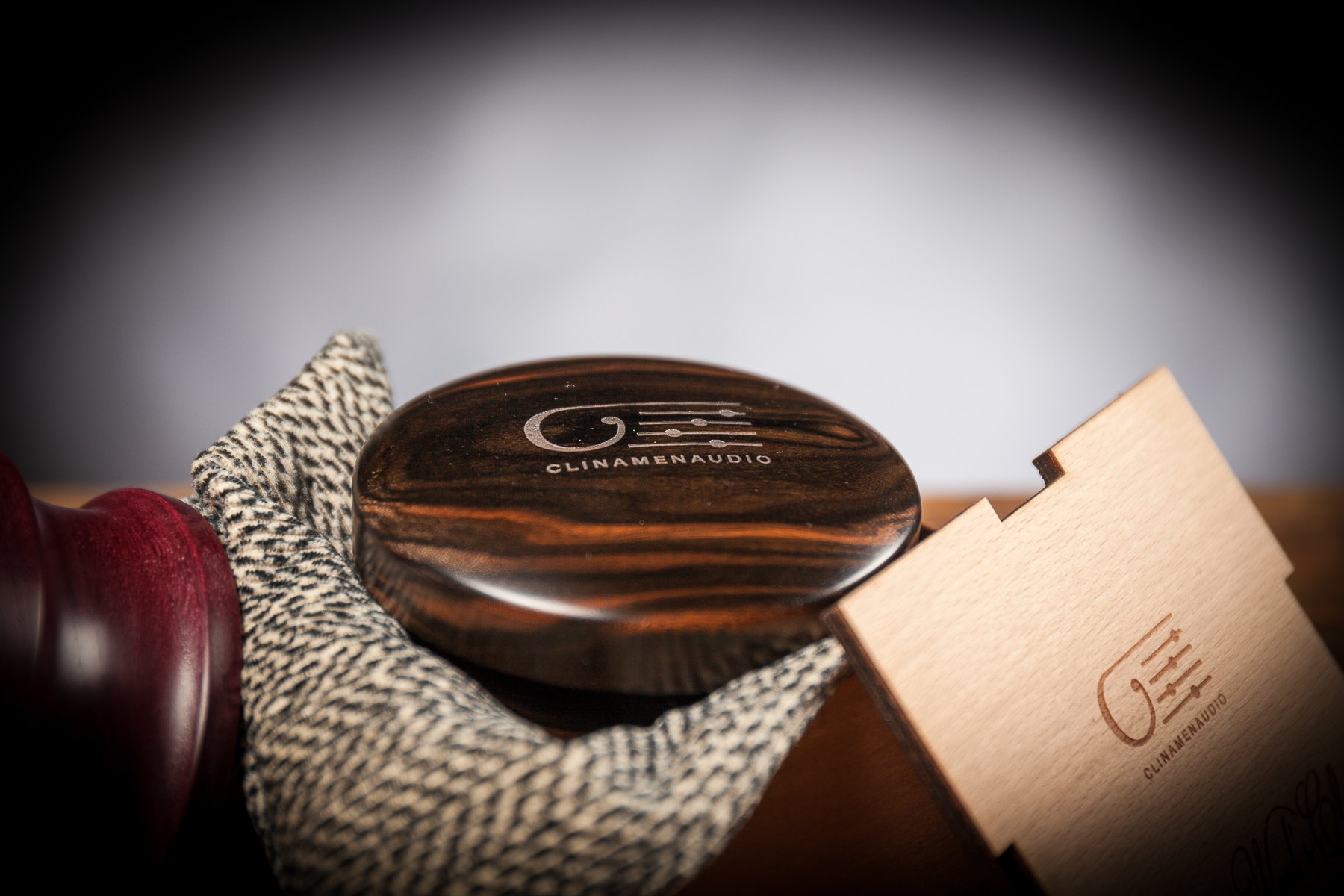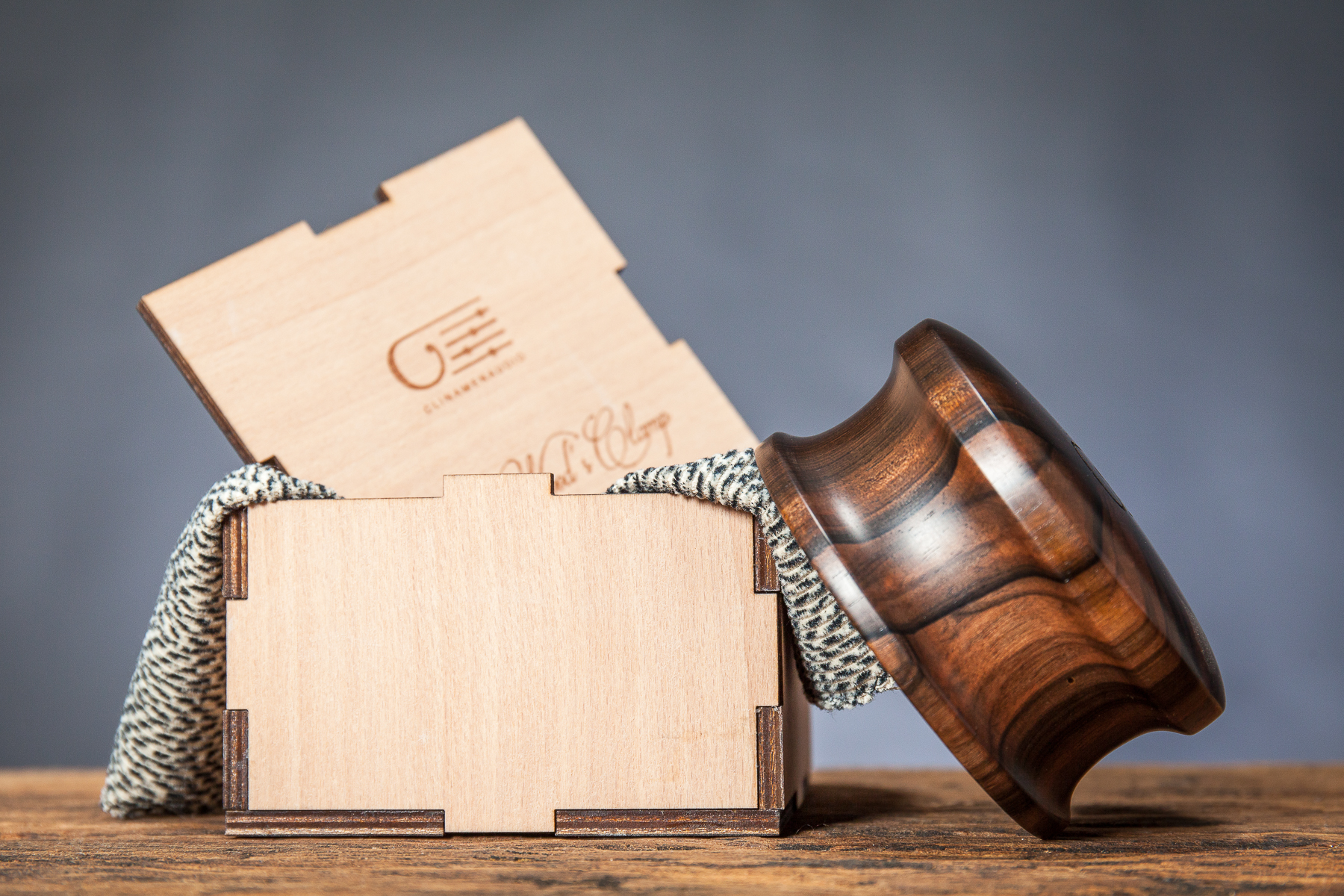Home |
Clinamen | Philosophy | Customer reviews | White paper | Pricing policy | Contact


Harmonic wood Clamps
Note on the updates:
In the MK3 version of the harmonic wood clamp it has been improved the coupling between the harmonic solid wood and the bronze insert . Now instead of interference, the coupling is made threading the two parts. This guarantees a optimal coupling between the two elements , with better acoustic performance. In the Mk4 version ( introduced in the 2022) the profile is slightly changed: the lower diameter it decreased, and the upper diameter is increased. Now the compatibilty of the Clinamen clamp MK4 is 100% with all the cartridges and the headshell, even the biggest ones.
One of the most interesting accessories offered by the Hi-End market for analog turntables is the Clamp. They are objects ,with a mass between 200-700 gr, generally made of metal or graphite. They are placed on top of the vinyl with the dual purpose of improving the mechanical coupling between plate and vinyl and treating the problem of residual vibrations.
After many tests carried out on clamps availables on the market, Clinamenaudio finds in the harmonic woods, coupling with metal inserts ( as bronze) are the right way for Natural sound. With the Harmonic wood clamp that we developed, we obtained the best results both in terms of naturalness and restitution of the emotional content of the musical message.
In the harmonic wood, the mechanical structure have a corrispective in the acoustic behaviour and in the damping property. As general rule, the harmonics woods have high specificy weight. The harmonic woods that we use in our clamps are:
- Macassar Ebony, (also called Camagon)
- Bubinga ( also called Kevazingo)
- Amaranth
- Goncalo Alves ( Tiger's wood)
- Palissandro Madagascar Rosewood
- Lignum Vitae ( guaiaco officinale)
Macassar Ebony is a wood similar to ebony but with more marked veins, of Indonesian origin, mostly. (the name derives from an Indonesian seaside town, Makassar, from which it is largely exported). It is used for the construction of guitars harmonic boxes, as well as the cocobolo. It provides a very clean sound with great dynamic contrast, with very defined bass.
Lignum Vitae, ( Guaiacum sanctum ) it is a very hard wood, indeed perhaps the hardest and heaviest in the world, it can reach the density of 1350 kg / m2. It is originally from Central America, and has many uses in the medical sector. The name Lignum Vitae is Latin, meaning tree of life, or wood of life, which derives from the multiple medicinal applications of the tree
Amaranth is a very beautiful wood, with a pink colour. It is used in luthiers . It have a high specific weight, between 800 and 1000Kg / m2. Typical of the Central America area, but it is also found in South America from Venezuela to Peru to Brazil.
Goncalo Alves: Goncalo Alves is commonly referred to as "Tigerwood" or "Brazilian Tigerwood". Typical of South America, the wood has high stiffness and hardness and a long service life. However, density and other mechanical properties can vary widely depending on the place of growth and the region of origin. The name "Jobillo" is sometimes used to refer to higher grades of Goncalo Alves among carpenters.
Bubinga (Kevazingo): Typical of equatorial Africa. It is a wood with an exceptional weight / resistance ratio, depending on the cut it can take on beautiful veins. Its density is 900 Kg / m2. Bubinga ranges from mauve-red to golden blonde and , when it get old, oxidizes to a beautifully and rich dark tones .
All the wood essences we use are aged for over 7 years, to ensure mechanical and dimensional stability. The wood blocks are machined with numerical control lathe. The finishing treatment, impregnation and wax polishing is hand made. On the top of the clamps there is the laser marking Clinamenaudio logo .
The clamps have a threaded bronze insert in the lower part, in which the hole for insertion in the turntable spindle is obtained. The bronze insert allows to perfectly calibrate the weight to the desired value of 350 gr. In addition, the combination of wood and metal allows to improve the damping of parasitic vibrations.
Raw clamps with the name of the wood essence
The Clinamenaudio harmonic wood clamps are lighter in comparison to what is usually offered by the market. The weight is around 360-400 gr (depending on the wood essences). This choice, supported by sonic and mechanical reasons, makes the clamps perfectly usable both on the idler-wheel and on the floating turntables: in fact, the small weight will not umbalancing the spring calibration of the floating turntables.
The clamps have a cavity at the bottom for the vinyl label in order to improve the interface characteristics and increase the contact pressure .
The clamps, made of natural material, can have small imperfections, which we prefer not to eliminate with acrylic paints with a high filling power, in order to leave the naturalness of the product preserved.
The clamps are supplied in an fashion laser-cut wooden box.
Contact us freely for the availability of the five models, since the supply of the raw material is discontinuous , and we only buy from importers who respect Nature, and certainly, our high quality standards.
We would also underline that each wooden essence we use has its own sound signature, so the listening results will be audibly different from one clamp to another. It is very interesting change the various clamps, according to your tastes, to the type of system and the music played. After listening the Clinamenaudio harmonic wood clamps, you can't go back.
Below is the extract of a Whatsapp conversation (not a proper review) with our customer Andrea Profidia from Rome who bought two clamps from us, the rosewood and the purpleheart.
Clinamen: "If you had to get rid of one of the two clamps you bought, which one would you keep?’
Andrea: ‘Look…or rather, listen..I love the rosewood because from what I can understand and hear it is wonderful on the mid low range…it gives me harmonic series that I really like…perhaps because it has a slightly bigger specific weight than the purpleheart. I found it has excellent performance with warm voices and rock music with a properly recorded bass line (now I’m listening to Quadrophenia)…but I think that the purpleheart behaves beautifully in the mid highs…the first time I listened to it, I realized I had never heard the cymbals so clearly…therefore I would like to keep both…it would be like choosing between two children. But if I really had to choose I would regretfully give up the purplewood‘
PRICES
We have here a pricing table, where we show the difference of price by essence or clamp quality, first or second choice. By second choice we mean that the wood has superficial imperfections. Since wood is a natural material it can have imperfections; but they don’t affect at all the sonorous performance. Nevertheless we think it’s fair to offer them at a lower price.
We want to point out that they are tiny imperfections that could have been corrected with grouting or an acrylic transparent lacquer. Nevertheless we prefer to keep the wax finishing to let the wood breathe and exalt its sonic/natural qualities.
| 1° choiche | 2° choice | |
| Makassar ebony | 350 | 290 |
| Amaranth | 330 | 270 |
| Rosewood | 320 | 260 |
| Lignum Vitae | 330 | 270 |
| Bubinga | 300 | 250 |
| Goncalo Alves | 330 | 250 |
| Ziricote | 350 | 290 |
USAGE AND MAINTENANCE NOTES
Since the clamps are made of wood, we strongly recommend not exposing them to direct sunlight and heat sources, such as the direct flow of a convector heater or by placing them on top of a radiator. Likewise big thermal surges must be avoided. We won’t accept any complaint if these advices are not followed.
For the maintenance of the wood it is possible to revive its luster by applying neutral high quality wood wax with a wool cloth. After letting it dry for about half an hour, wipe the wax layer away by rubbing vigorously with a pure wool cloth.


In the following link you can download Claudio Checchi review, from italy magazine" fedeltà del Suono" number 234:
At this link you can read On-line review of Harmonic wood clamp ( and MC Step up Clinamenaudio) on On-line Magazine TNT AUDIO
In the following link you can download Andrea Bedetti review, from italy magazine" Audiophile Sound "number 157:
In the end, Andrea Bedetti integration review, from Audiophile Extra 157:















